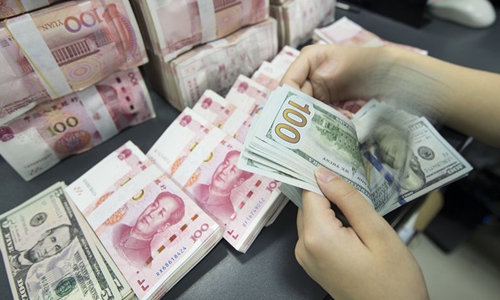HOME >> SOURCE
Yuan’s short-term depreciation is normal, to remain stable as epidemic subsides: experts
Source:Global Times Published: 2020/3/20 13:43:40

File Photo
The Chinese yuan’s recent depreciation against the US dollar is mainly short-term passive fluctuation amid the coronavirus’ rapid spread worldwide, experts said, adding that it will not affect the yuan’s long-term stable trend.
The yuan’s daily fixing rate weakened by 530 basis points to 7.1052 against the greenback on Friday, data from the China Foreign Exchange System showed, its weakest rate since March 2008.
China’s loan prime rates (LPR) on Friday were kept unchanged from their February levels, with both the one-year and five-year LPRs steady at 4.05 percent and 4.75 percent, respectively, according to the People’s Bank of China.
Following the release of the LPRs, the onshore Chinese yuan strengthened to 7.0964 per dollar. The offshore yuan also edged up, now standing at 7.1292 per dollar.
As the new coronavirus spreads rapidly worldwide, panic is on the rise in markets, leading to dollar appreciation as many investors seek a safe haven.
The US dollar index has been gaining since March 9, placing pressure on many countries’ currencies including China’s yuan.
“The yuan’s relative depreciation in the short term is not a concern as it is a passive fluctuation against the US dollar amid the pandemic, which will be a short-term impact,” said Liu Xuezhi, an economist at the Bank of Communications.
"It is not related to the fundamentals of the Chinese economy, which are on a steady trend with the nation’s gradual resumption of work and business," Liu told the Global Times on Friday.
Data shows that China has basically controlled the domestic spread of the coronavirus. The Chinese mainland on Wednesday reported zero new suspected COVID-19 cases for the first time since the outbreak began, and now the major focus has shifted toward the prevention of imported cases, the National Health Commission of China said in a press conference on Wednesday.
Liu believes the yuan’s exchange rate against the dollar will fluctuate around the 7 mark in the near future.
"As the epidemic subsides, the Chinese currency will gain strength," Liu added.
Data from Belgium-based financial messaging services provider SWIFT showed on Friday that the yuan’s share of currencies across global payments rose to 2.11 percent in February, up from January’s 1.65 percent and ranking fifth.
Global Times